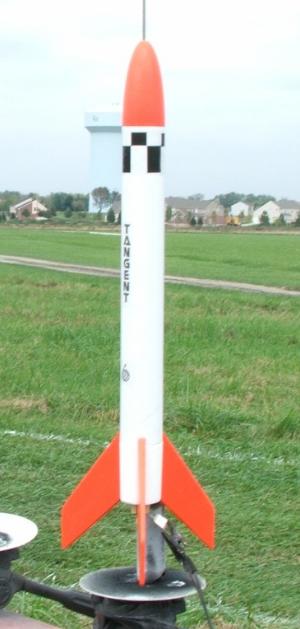| Construction Rating: | starstarstarstar_borderstar_border |
| Flight Rating: | starstarstarstar_borderstar_border |
| Overall Rating: | starstarstarstar_borderstar_border |
| Manufacturer: | Fun Rockets |
Brief:
The foam Tangent is one of the Doug Holverson designed rockets produced by Fun
Rockets under Doug's name. While certainly an innovative idea, it wasn't
necessarily a great business idea in the somewhat fickle world of low power
rocketry. The Tangent was selected for this comparison because it fit the
"low and slow" description, and despite its OOP status, it added a
little more color to the launches.
Construction:
Included in the sturdy, colorful box are a foam nose cone/main body
tube/assembled recovery system, three foam fins, and a foam and paper engine
mount/fin can.
The instructions that come with the Tangent are far and away the highlight of the kit. Doug has gone to great length to provide the beginning flyer with detailed information about how to go about achieving the best possible performance with the Tangent. Construction is simple to a fault. All one has to do to get this rocket ready to fly is slide the three large Styrofoam fins into their slots in the Styrofoam engine mount, secure them with some wood glue, then glue the assembled fin can into the rear of the body tube. Everything else is already done for you, right down to the packed parachute and the first load of recovery wadding.
Finishing:
This is a simple matter of affixing the self stick decals. Everything else is
pre-painted and with the exception of the stickers being too thick, the overall
look of the rocket is impressive.
Construction Rating: 3 out of 5
Flight:
Of the four rockets in this comparison, the Tangent is the most interesting
from a flight standpoint. Pre-loaded with recovery wadding and a comparatively
large parachute, the Tangent screamed off the pad on its initial C6-5 flight,
cocking into the wind. Ejection occurred as scripted, but the nose cone didn't
completely separate from the body tube at first and eventually pulled free as
the rocket started to fall. Upon inspection, it appeared that the rocket had
been pre-loaded with three tight fitting wads of recovery wadding which wedged
against the base of the nose cone instead of ejecting it.
The second flight was on a B6-4 and was noticeably lower than the previous flight. The Tangent on a B6-4 looks to be a great choice for those days when you fly from you local soccer field, as it winds up at a respectable height and cocks into the wind, which allows it to recover back near the pad when the breeze is factored in.
The third flight was on a B4-2 for a couple of reasons. First, I was told that it was a great small field motor for these big birds that allowed them to live up to their "low and slow" reputation. Second was because I was too tired to chase it very far and the B4-2 flight was low enough that the recovery walk was minimal. An interesting feature of each of the B4-2 flights that I made with the four different rockets that day was the little hitch that they made as they cleared the rod. It looked almost as if the rocket was making a course correction as all of them seemed to fall sideways ever so slightly before the thrust kicked in and sent them into the wind.
Recovery:
An interesting feature of the foam Tangent is the pre-built and pre-packed
recovery system. The Tangent comes with enough spare wadding wrapped in with
the instructions for several flights and three wads were already tightly packed
in the main body tube. As I mentioned earlier, it's probably a good idea to
take the chute and wadding out and repack them yourself because they seem to
have been shoved in awfully tight. The shock cord is pre-mounted and uses an
interesting mounting method. The elastic cord is tied through a piece of launch
lug, which is glued to the inside of the main body tube. The method seems
effective enough, although I'd consider it a bit suspect over a long period of
time.
The parachute is large and sturdy and in fact may be a little too large for some tastes. I cut a large reef hole in the chute, which seemed to have little effect on the performance of the recovery system except to allow it to recover closer to the pad. The descent rate is obviously quicker, but it is still slow enough to allow a damage free recovery.
Flight Rating: 3 out of 5
Summary:
The rocketry world is no worse off with the loss of the foam Fun Rockets
products, but seeing the Tangent pass into history with this as its last gasp
would be a shame. The balsa version of this rocket is one that is well worth
hunting down and I hope that the future holds a comeback for the Holverson
Designs half of this unfortunate partnership.
PROs: Great small field performance. Sharp looks from a distance. Instructions. The Holverson Designs/Fun Rockets saga is one of the odder stories in rocketry.
CONs: Cheesy foam. The fact that you can tell it's cheesy foam from close up. Sticker decals, also cheesy.
Overall Rating: 3 out of 5
Other Reviews
- Fun Rockets Tangent By Michael Rangitsch
Single staged sport rocket with parachute recovery. This is the redesign of the Holverson Designs Tangent . The nose cone, fins and fin can have been replaced by pre-colored expanded polystyrene versions. The shock cord is far longer than any supplied by Estes for similar rockets. Instructions are simple for this beginners rocket. Only white glue is needed for assembly. The new foam fins ...
 |
 |
Flights
Date | Flyer | Rocket | Altitude |
|---|---|---|---|
Sponsored Ads
 |
 |












